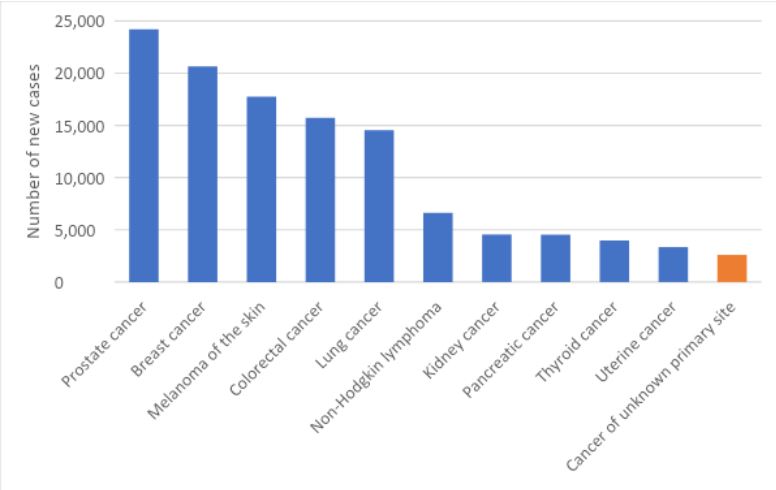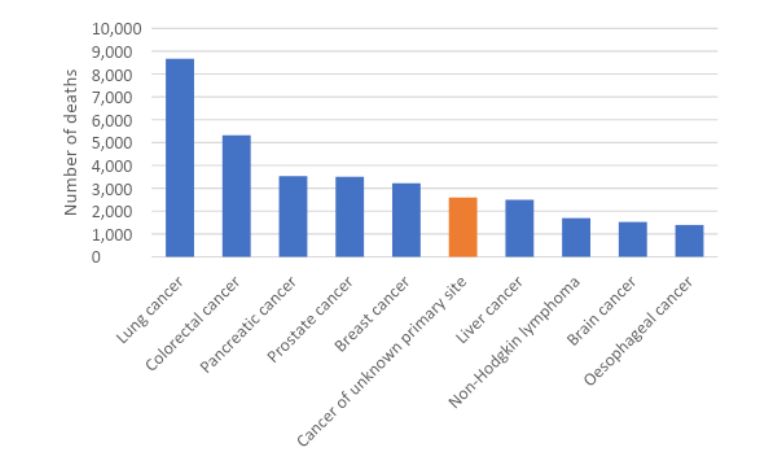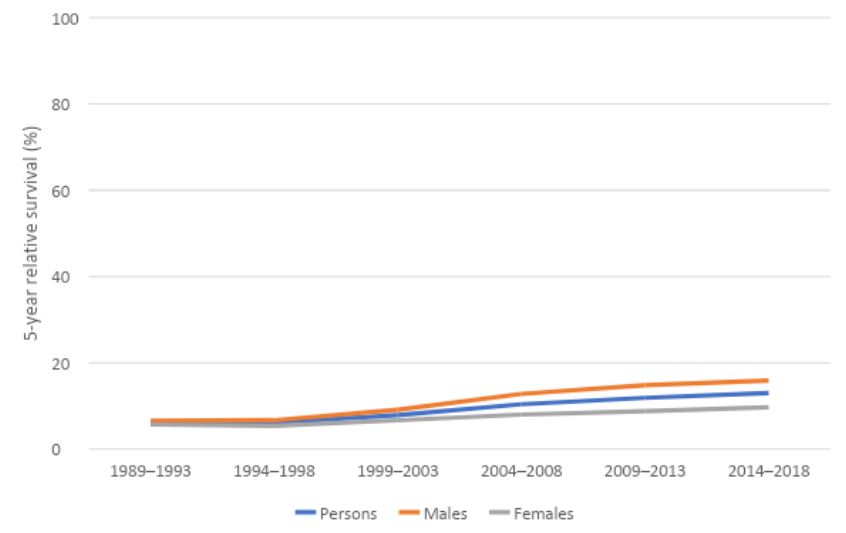The following material has been sourced from the Australian Institute of Health and Welfare
Cancer of unknown primary site incorporates ICD-10 cancer codes: Incidence C80 (Malignant neoplasm without specification of site); mortality C77–C80 (C77: Secondary and unspecified malignant neoplasm of lymph nodes, C78: Secondary malignant neoplasm of respiratory and digestive organs, C79: Secondary malignant neoplasm of other and unspecified sites; C80: Malignant neoplasm without specification of site), C97 (Malignant neoplasms of independent primary multiple sites).
Estimated number of new cases of cancer of unknown primary site diagnosed in 2022
2,596 =  1,452 males +
1,452 males +  1,144 females
1,144 females
Estimated % of all new cancer cases diagnosed in 2022
1.6%
Estimated number of deaths from cancer of unknown primary site in 2022
2,596 =  1,416 males +
1,416 males +  1,180 females
1,180 females
Estimated % of all deaths from cancer in 2022
5.2%
Chance of surviving at least 5 years (2014–2018)
13%
People living with cancer of unknown primary site at the end of 2017 (diagnosed in the 5 year period 2013 to 2017)
2,734
New cases
In 2018, there were 2,805 new cases of cancer of unknown primary site diagnosed in Australia (1,525 males and 1,280 females). In 2022, it is estimated that 2,596 new cases of cancer of unknown primary site will be diagnosed in Australia (1,452 males and 1,144 females). In 2022, it is estimated that a person has a 1 in 138 (or 0.72%) risk of being diagnosed with cancer of unknown primary site by the age of 85 (1 in 114 or 0.88% for males and 1 in 178 or 0.56% for females).

Figure 1. Estimated cancer incidence in Australia, 2022
Notes
- Data sourced from AIHW Cancer Data in Australia 2022 web report and supplementary data tables
- More information about incidence rates for the most common cancers diagnosed can be found on the NCCI website in the ‘Cancer incidence’ section (https://ncci.canceraustralia.gov.au/diagnosis/cancer-incidence/cancer-incidence)
In 2018, the age-standardised incidence rate was 9.1 cases per 100,000 persons (11 for males and 7.5 for females). In 2022, it is estimated that the age-standardised incidence rate will be 7.4 cases per 100,000 persons (9.2 for males and 5.8 for females). The incidence rate for cancer of unknown primary site is expected to increase with age.

Figure 2. Age-standardised incidence rates for cancer of unknown primary site, 1982 to 2018, by sex
Notes
- Data sourced from AIHW Cancer Data in Australia 2022 web report and supplementary data tables
- More information about incidence rates for cancer of unknown primary site over time, by age, sex, Indigenous status, remoteness, and socioeconomic status (SES) can be found on the NCCI website in the ‘Cancer incidence’ section (https://ncci.canceraustralia.gov.au/diagnosis/cancer-incidence/cancer-incidence)
The number of new cases of cancer of unknown primary site diagnosed increased from 2,141 (1,119 males and 1,022 females) in 1982 to 2,805 in 2018. Over the same period, the age-standardised incidence rate decreased from 18 cases per 100,000 persons (21 for males and 15 for females) in 1982 to 9.1 cases per 100,000 in 2018.
Deaths
In 2020, cancer of unknown primary site was the sixth most common cause of cancer death in Australia. It is estimated that it will remain the sixth most common cause of death from cancer in 2022.
In 2020, there were 2,633 deaths from cancer of unknown primary site in Australia (1,427 males and 1,206 females). In 2022, it is estimated that there will be 2,596 deaths (1,416 males and 1,180 females). In 2022, it is estimated that a person has a 1 in 139 (or 0.72%) risk of dying from cancer of unknown primary site by the age of 85 (1 in 120 or 0.83% for males and 1 in 165 or 0.61% for females).

Figure 3. Estimated cancer mortality in Australia, 2022
Notes
- Data sourced from AIHW Cancer Data in Australia 2022 web report and supplementary data tables
- More information about mortality rates for the most common causes of cancer death can be found on the NCCI website in the ‘Cancer mortality’ section (https://ncci.canceraustralia.gov.au/outcomes/cancer-mortality/cancer-mortality)
In 2020, the age-standardised mortality rate was 7.9 deaths per 100,000 persons (9.5 for males and 6.5 for females). In 2022, it is estimated that the age-standardised mortality rate will be 7.3 deaths per 100,000 persons (8.9 for males and 5.9 for females). The mortality rate for cancer of unknown primary site is expected to increase with age.

Figure 4. Age-standardised mortality rates for cancer of unknown primary site, 1982 to 2020, by sex
Notes
- Data sourced from AIHW Cancer Data in Australia 2022 web report and supplementary data tables
- More information about mortality rates for cancer of unknown primary site over time, by age, sex, Indigenous status, remoteness, and socioeconomic status (SES) can be found on the NCCI website in the ‘Cancer mortality’ section (https://ncci.canceraustralia.gov.au/outcomes/cancer-mortality/cancer-mortality)
The number of deaths from cancer of unknown primary site increased from 1,202 (609 males and 593 females) in 1982 to 2,633 in 2020. Over the same period, the age-standardised mortality rate remained similar from 10 deaths per 100,000 persons (12 for males and 8.9 for females) in 1982 to 7.9 deaths per 100,000 in 2020.
Survival
In 2014–2018, individuals diagnosed with cancer of unknown primary site had a 13% chance (16% for males and 10% for females) of surviving for five years compared to their counterparts in the general Australian population. Between 1989–1993 and 2014–2018, five-year relative survival for cancer of unknown primary site improved from 6.2% to 13%.

Figure 5. 5-year relative survival for cancer of unknown primary site, 1989–1993 to 2014–2018, by sex
Notes
- Data sourced from AIHW Cancer Data in Australia 2022 web report and supplementary data tables
- More information about 5-year relative survival rates for cancer of unknown primary site over time, by age, sex, Indigenous status, remoteness, and socioeconomic status (SES) can be found on the NCCI website in the ‘Relative survival rate’ section (https://ncci.canceraustralia.gov.au/outcomes/relative-survival-rate/5-year-relative-survival)
Prevalence
At the end of 2017, there were 936 people living who had been diagnosed with cancer of unknown primary site that year, 2,734 people living who had been diagnosed with cancer of unknown primary site in the previous 5 years (from 2013 to 2017) and 7,039 people living who had been diagnosed with cancer of unknown primary site in the previous 36 years (from 1982 to 2017).
For more information, see Unknown primary site (cancer of) on the NCCI website
The National Cancer Control Indicators (NCCI) are a set of indicators across the continuum of cancer care, from Prevention and Screening through to Diagnosis, Treatment, Psychosocial care, Research and Outcomes. The NCCI website allows users to see visual representations of data on each indicator through interactive charts.




